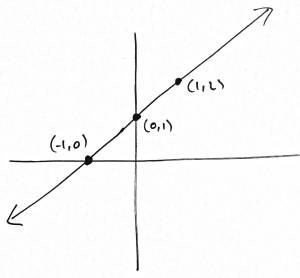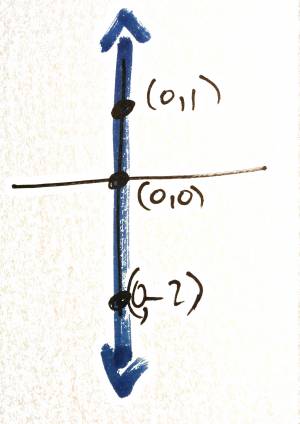Chapter 1: Systems of linear equations
Linear equations
First example: a linear equation in two variables
- Consider the equation \[ 2x+5y=7.\]
- This is an equation in two variables, or indeterminates, $x$ and $y$.
- A solution of this equation is a pair of numbers $(a,b)\in \mathbb{R}^2$ so that if we replace $x$ with $a$ and replace $y$ with $b$, then the equation becomes true.
- In other words, so that $2a+5b$ really is equal to $7$.
$2x+5y=7$
- $(3,1)$ is not a solution, because $2\times 3+5\times 1\ne 7$
- $(1,1)$ is a solution, because $2\times 1+5\times 1=7$
- Other solutions include $(0,\tfrac 75)$, $(0.5,1.2)$, $(6,-1)$, $(3.5,0)$, $(-\tfrac32,2)$, …
$2x+5y=7$
- We can't make a complete list of all solutions, since there are infinitely many solutions in $\mathbb{R}^2$. However, we can draw the set of all solutions as a subset of $\mathbb{R}^2$. This turns out to be a straight line

- $2x+5y=7$ is a linear equation in two variables.
Definition
If $a,b,c$ are any fixed numbers, then equation \[ ax+by=c\] is a linear equation in two variables.
When you draw the set of all solutions of a linear equation in two variables, you always get a straight line in the $x$-$y$ plane.
More examples of linear equations in two variables
- $y-x=1$

- $x-y=0$

- $x=0\iff 1x+0y=0$

Linear equations in 3 variables
Definition
If $a,b,c,d$ are any fixed numbers, then equation \[ ax+by+cz=d\] is a linear equation in 3 variables.
When you draw the set of all solutions of a linear equation in 3 variables, you always get a plane in 3-dimensional space, $\mathbb{R}^3$.
Examples
- $x+y+z=1$ <html><iframe scrolling=“no” src=“https://tube.geogebra.org/material/iframe/id/528999/width/800/height/503/border/888888/rc/true/ai/false/sdz/true/smb/false/stb/true/stbh/true/ld/false/sri/true/at/auto” width=“800px” height=“503px” style=“border:0px;”> </iframe></html>
- $x+y=1$ This may be viewed as a linear equation in 3 variables, since it is equivalent to $x+y+0z=1$. <html><iframe scrolling=“no” src=“https://tube.geogebra.org/material/iframe/id/529043/width/800/height/503/border/888888/rc/true/ai/false/sdz/true/smb/false/stb/true/stbh/true/ld/false/sri/true/at/auto” width=“800px” height=“503px” style=“border:0px;”> </iframe></html>
- $z=1$, viewed as the equation $0x+0y+z=1$ <html><iframe scrolling=“no” src=“https://tube.geogebra.org/material/iframe/id/529069/width/800/height/503/border/888888/rc/true/ai/false/sdz/true/smb/false/stb/true/stbh/true/ld/false/sri/true/at/auto” width=“800px” height=“503px” style=“border:0px;”> </iframe><br /></html>This plane is horizontal (parallel to the $x$-$y$ plane).
Linear equations (in general)
A linear equation in $m$ variables (where $m$ is some natural number) is an equation of the form \[ a_1x_1+a_2x_2+\dots+a_mx_m=b\] where $a_1,a_2,\dots,a_m$ and $b$ are fixed numbers (called coefficients) and $x_1,x_2,\dots,x_m$ are variables.
Example
\[ 3x_1+5x_2-7x_3+11x_4=12\] is a linear equation in 4 variables.
- A typical solution will be a point $(x_1,x_2,x_3,x_4)\in \mathbb{R}^4$ so that $3x_1+5x_2-7x_3+11x_4$ really does equal $12$.
- For example, $(-2,0,-1,1)$ is a solution.
- The set of all solutions is a 3-dimensional object in $\mathbb{R}^4$, called a hyperplane.
- Since we can't draw pictures in 4-dimensional space $\mathbb{R^4}$ we can't draw this set of solutions!
Systems of linear equations
A system of linear equations is just a list of several linear equations. By a solution of the system, we mean a common solution of each equation in the system.
Example
Find the line of intersection of the two planes $ x+3y+z=5$ and $ 2x+7y+4z=17$.
- <html><iframe scrolling=“no” src=“https://tube.geogebra.org/material/iframe/id/529147/width/800/height/503/border/888888/rc/true/ai/false/sdz/true/smb/false/stb/true/stbh/true/ld/false/sri/true/at/auto” width=“800px” height=“503px” style=“border:0px;”> </iframe></html>
Intersection of $ x+3y+z=5$ and $ 2x+7y+4z=17$
- To find the equation of the line of intersection, we must find the points which are solutions of both equations at the same time.
- Eliminating variables, we get $x=-16+5z$, $y=7-2z$
- The line of intersection consists of the points $(-16+5z,7-2z,z)$, where $z\in\mathbb{R}$
A detailed look at the last example
- $\begin{array}{ccccccrrr} x&+&3y&+&z&=&5&\quad&(1)\\ 2x&+&7y&+&4z&=&17&&(2)\end{array}$
- Find solutions of this system by applying operations
- Aim to end up with a very simple sort of system where we can see the solutions easily.
- $\begin{array}{ccccccrrr} x&+&3y&+&z&=&5&\quad&(1)\\ 2x&+&7y&+&4z&=&17&&(2)\end{array}$
- Replace equation (2) with $(2)-2\times (1)$:
- $\begin{array}{ccccccrrr} x&+&3y&+&z&=&5&\quad&(1)\\ &&y&+&2z&=&7&&(2)\end{array}$
- Now replace equation (1) with $(1)-3\times (2)$
- $\begin{array}{ccccccrrr} x&&&-&5z&=&-16&\quad&(1)\\ &&y&+&2z&=&7&&(2)\end{array}$
- $\begin{array}{ccccccrrr} x&&&-&5z&=&-16&\quad&(1)\\ &&y&+&2z&=&7&&(2)\end{array}$
- can easily rearrange (1) to find $x$ in terms of $z$
- can easily rearrange (2) to find $y$ in terms of $z$
- Since $z$ can take any value, write $z=t$ where $t$ is a “free parameter”
- (which means $t$ can be any real number, or $t\in \mathbb{R}$).
- Solution: \begin{align*} x&=-16+5t\\ y&=7-2t\\ z&=t,\qquad t\in \mathbb{R}\end{align*}
- Solution: \begin{align*} x&=-16+5t\\ y&=7-2t\\ z&=t,\qquad t\in \mathbb{R}\end{align*}
- Can also write this in “vector form”:
- $\begin{bmatrix} x\\y\\z\end{bmatrix}=\begin{bmatrix} -16\\7\\0\end{bmatrix}+t\begin{bmatrix} 5\\-2\\1\end{bmatrix},\qquad t\in \mathbb{R}.$
- This is the equation of the line where the two planes described by the original equations intersect.
- $\begin{bmatrix} x\\y\\z\end{bmatrix}=\begin{bmatrix} -16\\7\\0\end{bmatrix}+t\begin{bmatrix} 5\\-2\\1\end{bmatrix},\qquad t\in \mathbb{R}$
- For each value of $t$, we get a different solution (a different point on the line of intersection).
- e.g. take $t=0$ to see that $(-16,7,0)$ is a solution
- take $t=1.5$ to see that $(-16+1.5\times 5,7+1.5\times (-2),1.5) = (-8.5,4,1.5)$ is another solution
- etc.
- This works for any value $t\in\mathbb{R}$, and every solution may be written in this way.
Another look at the last example
- $\begin{array}{ccccccrrr} x&+&3y&+&z&=&5&\quad&(1)\\ 2x&+&7y&+&4z&=&17&&(2)\end{array}$
- Find solutions of this system by applying operations
- Aim to end up with a very simple sort of system where we can see the solutions easily.
- $\begin{array}{ccccccrrr} x&+&3y&+&z&=&5&\quad&(1)\\ 2x&+&7y&+&4z&=&17&&(2)\end{array}$
- Replace equation (2) with $(2)-2\times (1)$:
- $\begin{array}{ccccccrrr} x&+&3y&+&z&=&5&\quad&(1)\\ &&y&+&2z&=&7&&(2)\end{array}$
- Now replace equation (1) with $(1)-3\times (2)$
- $\begin{array}{ccccccrrr} x&&&-&5z&=&-16&\quad&(1)\\ &&y&+&2z&=&7&&(2)\end{array}$
- $\begin{array}{ccccccrrr} x&&&-&5z&=&-16&\quad&(1)\\ &&y&+&2z&=&7&&(2)\end{array}$
- can easily rearrange (1) to find $x$ in terms of $z$
- can easily rearrange (2) to find $y$ in terms of $z$
- Since $z$ can take any value, write $z=t$ where $t$ is a “free parameter”
- (which means $t$ can be any real number, or $t\in \mathbb{R}$).
- Solution: \begin{align*} x&=-16+5t\\ y&=7-2t\\ z&=t,\qquad t\in \mathbb{R}\end{align*}
- Solution: \begin{align*} x&=-16+5t\\ y&=7-2t\\ z&=t,\qquad t\in \mathbb{R}\end{align*}
- Can also write this in “vector form”:
- $\begin{bmatrix} x\\y\\z\end{bmatrix}=\begin{bmatrix} -16\\7\\0\end{bmatrix}+t\begin{bmatrix} 5\\-2\\1\end{bmatrix},\qquad t\in \mathbb{R}.$
- This is the equation of the line where the two planes described by the original equations intersect.
- $\begin{bmatrix} x\\y\\z\end{bmatrix}=\begin{bmatrix} -16\\7\\0\end{bmatrix}+t\begin{bmatrix} 5\\-2\\1\end{bmatrix},\qquad t\in \mathbb{R}$
- For each value of $t$, we get a different solution (a different point on the line of intersection).
- e.g. take $t=0$ to see that $(-16,7,0)$ is a solution
- take $t=1.5$ to see that $(-16+1.5\times 5,7+1.5\times (-2),1.5) = (-8.5,4,1.5)$ is another solution
- etc.
- This works for any value $t\in\mathbb{R}$, and every solution may be written in this way.
Observations
- The operations we applied to the original linear system don't change the set of solutions. This is because each operation is reversible.
- Writing out the variables $x,y,z$ each time is unnecessary:
- erase the variables from the system $$\begin{array}{ccccccrrr} x&+&3y&+&z&=&5&\quad&(1)\\ 2x&+&7y&+&4z&=&17&&(2)\end{array}$$
- write all the numbers in a grid, or a matrix
- we get $\begin{bmatrix} 1&3&1&5\\2&7&4&17\end{bmatrix}$
- System of linear equations: $\begin{array}{ccccccrrr} x&+&3y&+&z&=&5&\quad&(1)\\ 2x&+&7y&+&4z&=&17&&(2)\end{array}$
- $\begin{bmatrix} 1&3&1&5\\2&7&4&17\end{bmatrix}$ is called the augmented matrix of this linear system
- Each row corresponds to one equation.
- Each column corresponds to one variable
- (except the last column, which has the right-hand-sides of the equations)
- Instead of performing operations on equations, we can perform operations on the rows of this matrix.
\begin{align*} \begin{bmatrix} 1&3&1&5\\2&7&4&17\end{bmatrix} &\xrightarrow{R2\to R2-2\times R1} \begin{bmatrix} 1&3&1&5\\0&1&2&7\end{bmatrix} \\[6pt]&\xrightarrow{R1\to R1-3\times R1} \begin{bmatrix} 1&0&-5&-16\\0&1&2&7\end{bmatrix} \end{align*}
- Translate back into equations and solve:
- $\begin{array}{ccccccrrr} x&&&-&5z&=&-16&\quad&(1)\\ &&y&+&2z&=&7&&(2)\end{array}$
- $\begin{bmatrix} x\\y\\z\end{bmatrix}=\begin{bmatrix} -16\\7\\0\end{bmatrix}+t\begin{bmatrix} 5\\-2\\1\end{bmatrix},\qquad t\in \mathbb{R}.$
This method always works:
- take any system of linear equations
- write down a corresponding matrix (the augmented matrix)
- perform reversible operations on the rows of this matrix to get a “nicer” matrix
- write down a new system of linear equations with the same solutions as the original system.
- Hopefully the new system will be easy to solve…
- and the solutions haven't changed, so we'll have solved the original system!
The augmented matrix and elementary operations
Definition
Given a system of linear equations: \begin{align*} a_{11}x_1+a_{12}x_2+\dots+a_{1m}x_m&=b_1\\ a_{21}x_1+a_{22}x_2+\dots+a_{2m}x_m&=b_2\\ \hphantom{a_{11}}\vdots \hphantom{x_1+a_{22}}\vdots\hphantom{x_2+\dots+{}a_{nn}} \vdots\ & \hphantom{{}={}\!} \vdots\\ a_{n1}x_1+a_{n2}x_2+\dots+a_{nm}x_m&=b_n \end{align*} its augmented matrix is \[ \begin{bmatrix} a_{11}&a_{12}&\dots &a_{1m}&b_1\\ a_{21}&a_{22}&\dots &a_{2m}&b_2\\ \vdots&\vdots& &\vdots&\vdots\\ a_{n1}&a_{n2}&\dots &a_{nm}&b_n \end{bmatrix}.\]
The numbers in this matrix are called its entries.
Example
- Find the augmented matrix of the linear system\begin{align*}3x+4y+7z&=2\\x+3z&=0\\y-2z&=5\end{align*}
- We can rewrite it as \begin{align*}3x+4y+7z&=2\\{\color{red}1}x+{\color{red}0y}+3z&=0\\{\color{red}0x}+{\color{red}1}y-2z&=5\end{align*}
- So the augmented matrix is\[ \begin{bmatrix} 3&4&7&2\\1&0&3&0\\0&1&-2&5\end{bmatrix}.\]
Elementary operations on a system of linear equations
If we perform one of the following operations on a system of linear equations:
- list the equations in a different order; or
- multiply one of the equations by a non-zero real number; or
- replace equation $j$ by “equation $j$ ${}+{}$ $c\times {}$ (equation $i$)”, where $c$ is a non-zero real number and $i\ne j$,
then the new system will have exactly the same solutions as the original system. These are called elementary operations on the linear system.
Why do elementary operations leave the solutions of systems unchanged?
- We do the same thing to the left hand side and the right hand side of each equation…
- so any solution to the original system will also be a solution to the new system.
- These operations are all reversible (using operations of the same type)…
- so any solution to the new system will also be a solution to the original system.
Elementary row operations on a matrix
Translate elementary operations on the linear system into operations on the rows of the augmented matrix:
- change the order of the rows of the matrix;
- multiply one of the rows of the matrix by a non-zero real number;
- replace row $j$ by “row $j$ ${}+{}$ $c\times {}$ (row $i$)”, where $c$ is a non-zero real number and $i\ne j$.
- These operations are called elementary row operations or EROs on the matrix.
- The systems of linear equations corresponding to these matrices have exactly the same solutions.
Example
Use EROs to find the intersection of the planes \begin{align*} 3x+4y+7z&=2\\x+3z&=0\\y-2z&=5\end{align*}
Solution 1
\begin{align*} \def\go#1#2#3{\left[\begin{smallmatrix}#1\\#2\\#3\end{smallmatrix}\right]} \def\ar#1{\\\xrightarrow{#1}&} &\go{3&4&7&2}{1&0&3&0}{0&1&-2&5} \ar{\text{reorder rows}}\go{1&0&3&0}{0&1&-2&5}{3&4&7&2} \ar{R3\to R3-3R1}\go{1&0&3&0}{0&1&-2&5}{0&4&-2&2} \ar{R3\to R3-4R2}\go{1&0&3&0}{0&1&-2&5}{0&0&6&-18} \ar{R3\to \tfrac16 R3}\go{1&0&3&0}{0&1&-2&5}{0&0&1&-3} \end{align*}
$\go{1&0&3&0}{0&1&-2&5}{0&0&1&-3}$
- from the last row, we get $z=-3$
- from the second row, we get $y-2z=5$
- so $y-2(-3)=5$
- so $y=-1$
- from the first row, we get $x+3z=0$
- so $x+3(-3)=0$
- so $x=9$
- Conclusion: $\begin{bmatrix}x\\y\\z\end{bmatrix}=\begin{bmatrix}9\\-1\\-3\end{bmatrix}$ is the only solution.
Solution 2
We start in the same way, but by performing more EROs we make the algebra at the end simpler.
\begin{align*} \def\go#1#2#3{\left[\begin{smallmatrix}#1\\#2\\#3\end{smallmatrix}\right]} \def\ar#1{\\\xrightarrow{#1}&} &\go{3&4&7&2}{1&0&3&0}{0&1&-2&5} \ar{\ldots \text{same EROs as above}\ldots}\go{1&0&3&0}{0&1&-2&5}{0&0&1&-3} \ar{R2\to R2+2R3}\go{1&0&3&0}{0&1&0&-1}{0&0&1&-3} \ar{R1\to R1-3R3}\go{1&0&0&9}{0&1&0&-1}{0&0&1&-3} \end{align*}
\[ \go{1&0&0&9}{0&1&0&-1}{0&0&1&-3}\]
- from the last row, we get $z=-3$
- from the second row, we get $y=-1$
- from the first row, we get $x=9$
- So $\begin{bmatrix}x\\y\\z\end{bmatrix}=\begin{bmatrix}9\\-1\\-3\end{bmatrix}$ is the only solution.
Discussion
Both solutions use EROs to transform the augmented matrix.
- Solution 1: $\left[\begin{smallmatrix}1&0&3&0\\0&1&-2&5\\0&0&1&-3\end{smallmatrix}\right]$.
- “Staircase pattern”: 1s on “steps”, zeros below steps
- Called row echelon form
- Needed algebra to finish solution.
- Solution 2: $\left[\begin{smallmatrix}1&0&0&9\\0&1&0&-1\\0&0&1&-3\end{smallmatrix}\right]$
- Staircase with zeros above 1s on steps (and below).
- Called reduced row echelon form
- No extra algebra needed to finish solution.
